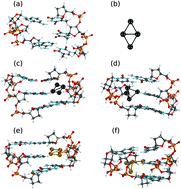Optical absorption in complexes of abasic DNA with noble-metal nanoclusters by first principles calculations
Abstract
Abasic sites (AP site) in a DNA duplex have been experimentally used to produce fluorescent Ag nanoclusters (NC) with a small number of atoms (n ≤ 6). These AP-DNA:NC complexes act as biological makers that help to locate genes associated with diseases related to single nucleotide polymorphisms (SNP), for example. Abasic sites are the most common SNP genetic variation, and their detection may help predict a host of genetically determined diseases. In this work, we report a theoretical study of the optical absorption spectra of AP-DNA:Ag4 and AP-DNA:Au4 complexes using a fully ab initio methodology. We consider several different base environments for the noble-metal nanocluster occupying the AP site, and compute the absorption spectra of sixteen AP-DNA:Ag4 and sixteen AP-DNA:Au4 complexes. We find that optical absorption in the AP-DNA:Ag4 complexes tends to concentrate in the green-to-violet range of frequencies (2.50 eV ≤ ħω ≤ 3.2 eV) and that AP-DNA:Au4 complexes display absorption peaks in the violet-to-ultraviolet interval (ħω ≥ 3.0 eV). An analysis of the optical absorption mechanisms in these complexes shows that they can be of local, charge-transfer, or hybrid nature, i.e., AP-DNA:NC complexes display the full variety of optical absorption processes in molecular systems. In particular, we identify both charge-transfer and hybrid processes involving several DNA bases surrounding the NC. Importantly, we find that even sequences where the Ag4 cluster is not in a guanine rich neighborhood display absorption peaks in the visible-light spectrum. Moreover, we obtain that the maximum intensities of the absorption peaks in complexes with pyrimidine vacancies are generally higher than those in complexes with purine vacancies. Regarding the selectivity of single-vacancy AP-DNA to specific noble-metal nanocluster sizes, our calculations show that the four-atom Ag4 (Au4) species fits naturally and binds into the AP-site in a single-vacancy AP-DNA.



 Please wait while we load your content...
Please wait while we load your content...